
A Guide to California's
Reptiles and Amphibians
Sounds of
Foothill Yellow-legged Frog - Rana boylii
Baird, 1854
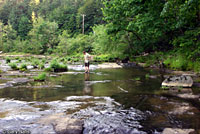
Breeding area

Frog underwater in Breeding area
More pictures and information:
Page 1: Frogs and Habitat
Page 2: Eggs and Tadpoles
Oregon frogs and habitats
Watch short movies and hear
more sounds of this frog at
Endangered Species International
(www.endangeredspeciesinternational.org)
|
Male frogs and toads sometimes make a variety of sounds. These calls can have different functions. Advertisement Calls The advertisement call is the most well-known call of a frog or toad. It is made by a male during the breeding season to establish his territory and repel rival males and to attract females as potential mates. Males usually make the call in or near bodies of water near areas that are attractive to a female as a good place to lay her eggs. Advertisement calls can be heard during the evening and at night, and often during daylight at the peak of the breeding season. Sometimes an advertisement call will be heard outside of the breeding season and away from water. The reason for this is not understood. Each species has its own unique advertisement call. This is necessary to differentiate them when there is more than one species calling. The evolution of this specific male advertisement call and its recognition by females is considered to be an important isolating mechanism in the evolution of a species. |
||||
The calls of Rana boylii are not commonly heard. Calls are made at night and during the day in the air and underwater, but the paired vocal sacs (shown below) are very small and do not produce much volume. The sound of running water from the rivers and streams where this frog breeds also help to cover up the calls. The main call can be described as a faint one-note low-pitched, raspy series of 4 - 6 notes per second. Grunts and oinks may also be heard, along with rattling. "R. boylii has a well-developed vocabulary of several call types. Such calling is normally associated with species in which males defend territories vocally, and often by physical combat if vocal threats fail. In such species, males do not usually actively search for and clasp females, but rather wait until the female has contacted them before attempting amplexus." However, this may not adequately described R. boylii as males have been observed initiating amplexus when females are very close. * |
||||
| Underwater Calls | ||||
With the assistance of Oregon biologist Chris Rombough, the following recordings were made with an underwater microphone on June 26th from about 10:00 PM to midnight in the quiet waters at the edge of a river (shown to the left) in Linn County, Oregon. Air temperature was 78 degrees F, water temperature 65 degrees F. Several male frogs were gathered in a small pool near some recently-deposited egg masses. Other frogs were situated in nearby pools and their calls could be heard faintly. None of these underwater calls could be heard from the air. |
||||
| This is a 5 second edit of three short underwater calls from one frog (with long pauses in-between edited out.) | ||||
| This is an 18 second composite of some of the various underwater sounds made by several frogs, taken from various recordings. | ||||
| This is a 40 second recording of underwater sounds made by a group of frogs. |
||||
| This is a 59 second recording of underwater sounds made by a group of frogs. | ||||
The following recording was made with an underwater microphone on the morning of June 27th in the same location as the above recordings. Air temperature was 78 degrees F, water temperature 66 degrees F, skies were sunny. Three male frogs were gathered in the same small pool where the above night recordings were made. Again, none of these underwater calls could be heard from the air. Occasionally a frog would surface and produce a very faint call in the air once or twice before remaining silent for several minutes, then returning underwater. Unfortunately, these air calls were not recorded and cannot be heard here. |
||||
| This is a 21 second recording of underwater sounds made by two frogs. | ||||
| |
||||
The following recording was made with an underwater microphone at the same location as above, but two years later, on a sunny afternoon. |
||||
| This is a 1 minute and 43 second recording of a frog made with an underwater microphone. The frog begins calling in the air with its head out of the water and its throat sack on the surface of the water. He then dives underwater and continues calling. These sounds correspond to the frog in the second video seen below, including the sounds made after you see the frog dive into the water. | ||||
| |
||||
 |
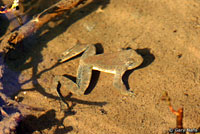 |
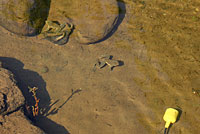 |
||
| Adult male in underwater calling position next to egg sack. |
Adult male in underwater calling position |
Frogs in breeding pool (near underwater microphone) |
||
| Calls in Air (Not Underwater) | ||||
The following recordings are of frogs calling in the air at the same location as the underwater calls heard above, but two years later, on a sunny morning and afternoon. Air temperature was about 75 - 80 degrees F, water about 65 degrees F. These frogs have their heads out of the water, but their lower bodies are partially in shallow flowing water. Frogs recorded here are shown below. |
||||
| This is a 3 second recording of a frog calling in the air while sitting at the edge of a pool about 30 feet from the shore of a river. Rushing water is heard in the background. |
||||
| This is a 13 second recording of a frog calling in the air while sitting at the edge of a pool about 30 feet from the shore of a river. Rushing water is heard in the background. |
||||
| This is a 35 second recording of a frog calling and moving towards the microphone. It begins with the frog calling while sitting at the edge of a pool. The frog then begins to advance over a large rock with very shallow water flowing over it. He eventually crawls all the way up to the microphone stand, calling all the time, including while he is sitting on rock completely out of the water. |
||||
 |
 |
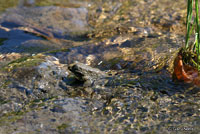 |
||
| Males in air-calling position, Linn County, Oregon |
||||
Release Calls A release call is produced by a male frog or an unreceptive female frog when a male frog or other animal gets on its back and grabs its sides in the position used for mating or amplexus. It's a frog's way of saying "Get off my back! Let go!" |
||||
| This is a 2 second recording of two short release calls of a male frog as it was grabbed across the back. It was recorded in the air. Flowing water can be heard in the background. | ||||
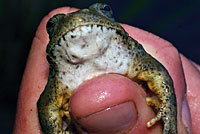 |
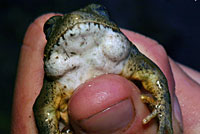 |
|||
| Adult male with paired vocal sacs not inflated (left) inflated (right) |
||||
| Waveform and Sonogram | ||||
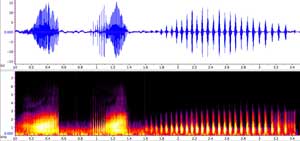 |
||||
| This is a recording of the underwater calls of a Foothill Yellow-legged Frog recorded during the day in Linn County, Oregon. The image above is a visual representation of this call. Click on it to see a larger image. Click here for information about how to read the waveform and sonogram images. |
||||
| Short Videos | ||||
 |
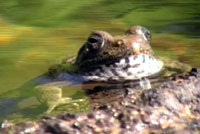 |
|||
| Scenes from a Foothill Yellow-legged Frog breeding site along a river in Oregon, including calls made in the air and underwater. (The underwater calls were not recorded along with the video, they were added later, however, the frogs depicted underwater are calling male frogs.) |
A Foothill Yellow-legged frog calls at the edge of a small pool in a river with just its head out of the water, producing a call that can be heard in the air and underwater. The sounds heard here were recorded with an underwater microphone placed about 3 feet behind the frog. | |||
You can listen to more sounds of Foothill Yellow-legged Frogs on this cd: Carlos Davidson - Frog and Toad Calls of the Pacific Coast  and on the cd that comes with this book: Lang Elliott, Carl Gerhardt, and Carlos Davidson - The Frogs and Toads of North America - Houghton Mifflin Harcourt. 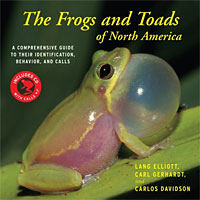 |
||||
* Laine MacTague and Philip T. Northern - Underwater Vocalization by the Foothill yellow-legged Frog (Rana boylii) 1993. Transactions of the Western Section of the Wildlife Society 29:1-7. |
||||
Return to the Top
© 2000 -